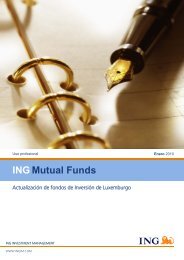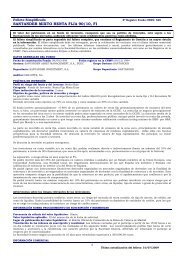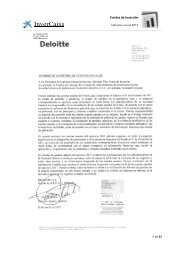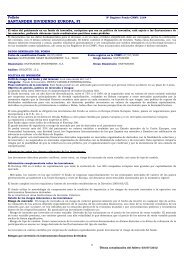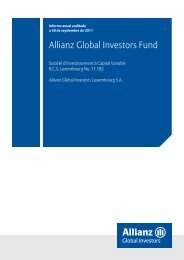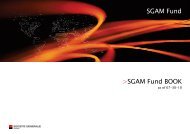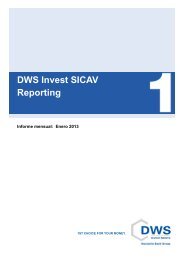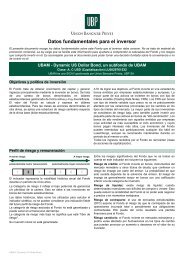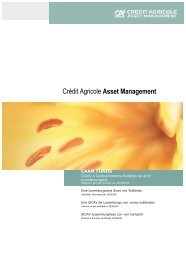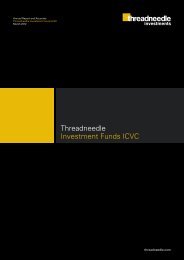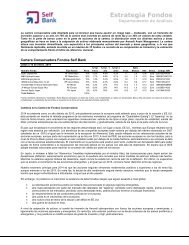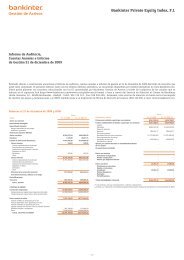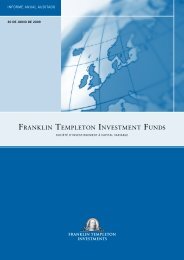Aberdeen Global II - Self Bank
Aberdeen Global II - Self Bank
Aberdeen Global II - Self Bank
- No tags were found...
You also want an ePaper? Increase the reach of your titles
YUMPU automatically turns print PDFs into web optimized ePapers that Google loves.
Canadian Dollar BondFor the period 24 September 2010 to 30 June 2011PerformanceFor the period 24 September 2010 to 30 June 2011, the value of Canadian Dollar Bond - A Accumulation shares increased by 1.14% comparedto an increase of 1.10% in the benchmark, JP Morgan Government Bond Index Traded CAD.Source: Lipper, Basis: total return, NAV to NAV, net of annual charges, gross income reinvested, CAD.Corporate activityOn 24 September 2010, Credit Suisse Bond Fund (Lux) CA$ <strong>Aberdeen</strong> transferred its assets into the <strong>Aberdeen</strong> <strong>Global</strong> <strong>II</strong> - Canadian DollarBond Fund resulting in a contribution in kind worth CA$138 million in investments and cash.Shareholders involved in the transfer were given A shares in the <strong>Aberdeen</strong> <strong>Global</strong> <strong>II</strong> - Canadian Dollar Bond Fund for every 1 share previouslyheld in Credit Suisse Bond Fund (Lux) CA$ <strong>Aberdeen</strong> as follows:Contribution inCredit Suisse Bond Fund (Lux) Share Class <strong>Aberdeen</strong> <strong>Global</strong> <strong>II</strong> Share Classkind (‘000) Transfer RatioCA$ <strong>Aberdeen</strong> A Canadian Dollar Bond Fund A-1 CA$41,066 1.000300090CA$ <strong>Aberdeen</strong> B Canadian Dollar Bond Fund A-2 CA$96,977 1.000300090Manager’s reviewInvestors had much to digest over the 12-month period. Once themarkets recovered following the sell-off sparked by the Gulf ofMexico oil spill, ongoing political tensions in North Africa and theMiddle East, swiftly followed by the tragic earthquake in Japanled to a renewed bout of risk aversion. Concerns also began tosurface around the US debt profile which was best summarised byS&P’s downgrading of the US debt outlook to negative. Peripheraleurozone countries came under severe pressure from bond investorsconcerned over levels of indebtedness. Yields on peripheral sovereigndebt rose significantly as investors shunned the bond market. Greecewas the first peripheral nation to undergo a crisis, followed byIreland in the fourth quarter of 2010 and Portugal in the secondquarter of 2011. EU/IMF bailouts failed to calm the markets asexpected and fears about the fiscal situation in other Eurozonecountries kept yield spreads versus German bunds at recordhigh levels. Towards the end of the year under review, fears ofGreek default dominated the markets and led to the widespreadrisk aversion.Amidst all of these headwinds, Canada’s economy has beenmotoring along very nicely and, were it not for the uncertain globallandscape and US rates at near zero, an interest rate rise would havesurely been implemented by the <strong>Bank</strong> of Canada in an effort tostem inflationary pressures and stop the economy from overheating.Headline inflation is currently running at 3.7%, significantly abovethe <strong>Bank</strong> of Canada’s 1-3% target range.Whilst the July inflation figure is expected to fall due to 2010 highersales taxes dropping out of the data, the <strong>Bank</strong> of Canada’s coreinflation rate, which excludes sales taxes and volatile goods, couldsee rises over the coming months due to similar year-on-year datacomparisons. At 1.9%, the annualised core inflation figure wouldstill be below the 2% target; however, the rate of increase will be ofconcern to the <strong>Bank</strong> of Canada. Also of concern to the central bankwill be the marginal rise in inflation expectations highlighted in itsQ2 Business Outlook Survey.Portfolio reviewThe Fund outperformed its benchmark over the period under review,returning 1.14% versus the benchmark’s performance of 1.10%.Overall, government of Canada bond yields are slightly lower overthe reporting period of June 2010 through June 2011. Thirty yearbonds are about ten basis points lower and ended the period with ayield of 3.55%, ten year bonds were roughly unchanged at 3.1%, fiveyear bonds were unchanged at 2.3% and two year bonds ended theperiod about 0.2% wider at 1.6%.In terms of interest rate sensitivity, the Fund had lower durationthan the benchmark in the second half of the reporting period, thisresulted in some give-up of yield and less capital gains than thebenchmark given the overall lower yield curve. This was more thanoffset from holding a few well selected Canadian dollar denominatedcorporate bonds and Canadian provincial bonds; both of thesetypes of bonds offer a yield pick-up versus sovereign government ofCanada bonds. Furthermore holding some higher yielding off-therunCanada government bonds that also benefited from rolling downthe yield curve further benefited the Fund.OutlookWith uncertainties surrounding the pace of US growth from here,and with nothing immediately forcing the hand of the <strong>Bank</strong> ofCanada, we continue to expect them to remain in ‘wait and see’mode. There is no desire to open a large differential to US rates,especially whilst the currency remains so resilient.24 <strong>Aberdeen</strong> <strong>Global</strong> <strong>II</strong>Canadian Dollar Bond



